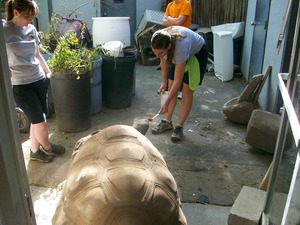Traditional animal training, either for dogs or for exotics, leaned heavily on punishment. Hit the dog with a newspaper for peeing on the carpet, using a whip to get the tiger to jump, beating the elephant with a hook. Old-school trainers needed to dominate their animals and used fear to get them to do what they wanted. Thankfully, animal training has done a complete 180. Progressive trainers use only positive reinforcement techniques, working on communication and cooperation with the animal.
Today this training technique is used for all zoo animals, from orangutans to tortoises. With dogs, it’s called “clicker training” or “affection training. Whatever you call it, the principles are the same.
Trust Bank
Positive interactions are a deposit in the trust bank, negative ones are a withdrawal. When you praise your dog, give him a treat, or throw that ball, you build up a balance of good feelings. When something unpleasant happens, such as yelling, swatting, or taking away a favorite toy, you make a withdrawal. Best to keep the balance in the black. Our six-year-old orangutan needed to get several shots for immunizations. She willingly sat still and let the vet poke her five times, all in return for Skittles. Because her keepers and the vet staff had a large balance of positive interactions, she knew that a little discomfort was going to be totally worth it in rewards!
What do you want?
So your dog jumps on your guests. Rather than focus on “stopping” your dog, think about what the ideal behavior would be. Maybe it’s sitting calmly, lying down, or staying in the kitchen until you call them in to greet someone. Often it’s easier to redirect and teach good behavior rather than stop bad behavior. We have a troublesome camel who loves to knock over the poop-filled wheelbarrow. Her keepers have taught her to “station” to a certain area in her enclosure. As long as she stays there, the treats keep coming. If she leaves, she’s asked to go back and rewarded for doing so. Instead of bopping her on the nose for coming near the wheelbarrow, she’s now being rewarded for doing something else…that also happens to leave her keepers in peace!
What is the consequence?
Animals work on a system of action and consequence. If something good happens as a result of a behavior, it increases the chance of the animal doing it again. The key is to think about what you are rewarding. If keepers walk away from an aggressive tiger every time she roars, we are actually rewarding that behavior. She’ll roar more, because it gets her what she wants. Instead we ask her to lay down, and then walk away. Why does your dog pull on his leash, even though he’s choking himself? Because pulling gets him what he wants; going forward. So how can you change the consequence? Every time the dog pulls, go the other direction.
Good animal training takes patience. It takes time for an animal to figure out what it needs to do. By taking small steps towards an ultimate goal, you’ll be able to progress faster than if you force an animal too quickly. When training monkeys to go into a crate, keepers first reward the animal for just looking at it. Then for coming closer, then for going partway in, until the animal willingly climbs in and allows the door to be closed. Expecting a monkey to jump right in on the first day would be foolish, and break the trust that animal has in the trainer. Got a nervous dog who hates going in the car? Your first step might be simply getting the dog comfortable hanging out next to the car with the door open. When you see him relax, then bribe him into the car with a treat and leave all the doors open. Each step should be solid and confident before moving on the to next one.
When training any animal, it’s always best to have a relationship built on trust. Positive reinforcement adds to the good feelings between human and animal, whether it’s a keeper and a cougar or a boy and his dog.
Ellen has been a zookeeper and animal trainer for seven years. She has trained animals from gorillas to iguanas, and has also trained her cat to sit!
More Articles from this Contributor
Crate Train Your Kitten
Keeping Records on Zoo Animals and Pets
Why Pets and Zoo Animals Need Regular Weighing





![Housebreaking an Older [Male] Dog 300_52285](https://karla.news/wp-content/uploads/2023/08/300_52285-150x150.jpg)

